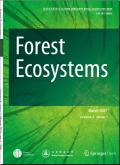Quantifying unseen woody biomass and diversity in understorey trees and shrubs at the extremes of water availability in the Miombo ecoregion
IF 4.4
1区 农林科学
Q1 FORESTRY
引用次数: 0
Abstract
The Miombo ecoregion covers eastern and southern Africa, with variations in plant species composition, structure, and biomass across a broad precipitation gradient. Most studies of woody plant communities focus exclusively on larger overstorey trees (≥5 or ≥10 cm stem diameter), overlooking the contribution of small trees and shrubs in the understorey, which can comprise a significant portion of total biomass and diversity. Here, we evaluate the contribution of both large overstorey and small understorey woody plants to species diversity and above-ground biomass (AGB), with 17 plots (0.5–1 ha) across five sites representing both extremes of rainfall gradient spanning the Miombo ecoregion, in northeast Namibia (500–700 mm mean annual precipitation, MAP) and southern Democratic Republic of Congo (DRC) (>1,200 mm MAP).
Mean AGB per site ranged from 21 to 119 Mg⋅ha⁻1, increasing with rainfall, while the proportional AGB contribution of small trees, saplings, and shrubs decreased. In dry Namibia, small trees, saplings, and shrubs (<5 cm DBH) contributed up to 28.2% of total AGB (mean ± standard deviation: 18.3% ± 3.4%), whereas in wet DRC, they contributed only up to 2.5% (2.3% ± 1.4%).
Namibian sites, on average, contained a large proportion of woody species diversity exclusively in small trees and shrubs (<5 cm DBH), with 55 species representing 59.4% of the total diversity. In contrast, DRC sites had higher overall small woody plant diversity (66 species) but fewer species found exclusively as small individuals (25.2%), with many saplings that grow to larger trees. Understorey composition also differed, with saplings of overstorey trees dominating in DRC, while shrubs dominated in Namibia.
Our findings show that woody biomass and diversity in dry woodlands are substantially underestimated when studies focus only on larger trees. This highlights the need to consider all woody vegetation to better understand woody plant diversity and biomass variation.
在Miombo生态区域的极端水可用性下,量化看不见的木质生物量和林下树木和灌木的多样性
Miombo生态区覆盖非洲东部和南部,植物种类组成、结构和生物量在广泛的降水梯度上发生变化。大多数关于木本植物群落的研究只关注较大的林下乔木(茎直径≥5 cm或≥10 cm),而忽视了林下小树和灌木的贡献,它们可能占总生物量和多样性的很大一部分。本文利用纳米比亚东北部(平均年降水量500-700 mm)和刚果民主共和国南部(平均年降水量1200 mm) 5个地点的17个样地(0.5-1 ha),评估了大型和小型下层木本植物对物种多样性和地上生物量(AGB)的贡献。每个站点的平均AGB范围为21 - 119 Mg⋅ha⁻1,随着降雨量的增加而增加,而小树、树苗和灌木对AGB的贡献比例则下降。在干燥的纳米比亚,小树、树苗和灌木(5 cm DBH)占总AGB的28.2%(平均值±标准差:18.3%±3.4%),而在潮湿的刚果民主共和国,它们仅占2.5%(2.3%±1.4%)。平均而言,纳米比亚样地的木本物种多样性主要集中在小树和灌木(5 cm DBH),共有55种,占总多样性的59.4%。相比之下,刚果民主共和国样地的小型木本植物总体多样性较高(66种),但仅为小型个体的物种较少(25.2%),其中许多树苗长成大树。林下组成也存在差异,刚果民主共和国以林下树苗为主,而纳米比亚以灌木为主。我们的研究结果表明,当研究只关注较大的树木时,干燥林地的木质生物量和多样性被大大低估了。这突出了考虑所有木本植被以更好地了解木本植物多样性和生物量变化的必要性。
本文章由计算机程序翻译,如有差异,请以英文原文为准。
求助全文
约1分钟内获得全文
求助全文
来源期刊

Forest Ecosystems
Environmental Science-Nature and Landscape Conservation
CiteScore
7.10
自引率
4.90%
发文量
1115
审稿时长
22 days
期刊介绍:
Forest Ecosystems is an open access, peer-reviewed journal publishing scientific communications from any discipline that can provide interesting contributions about the structure and dynamics of "natural" and "domesticated" forest ecosystems, and their services to people. The journal welcomes innovative science as well as application oriented work that will enhance understanding of woody plant communities. Very specific studies are welcome if they are part of a thematic series that provides some holistic perspective that is of general interest.
 求助内容:
求助内容: 应助结果提醒方式:
应助结果提醒方式:


